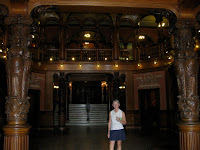With a good nights sleep we were rejuvenated and ready to explore Charleston. The KOA staff gave us a good suggestion to park Moho and use the water taxi. It was a short scenic ride and saved us the hassle of traffic and parking in downtown Charleston. An added bonus was the swimming dolphins along side the water taxi.
Charles Town named for King Charles I was established in 1670. Charleston was the capital of the Carolina colony and the southernmost point of English settlement in the late 1600's. By the mid-18th century it had become the wealthiest and largest city south of Philadelphia and the centre of a successful shipping industry. Following independence from Britain Charleston became more prosperous in the plantation dominated economy. The invention of the cotton gin in 1793 revolutionized production and it quickly became South Carolina's major export. Of course, plantations relied heavily on slave labour. On December 20, 1860 South Carolina voted to secede from the Union making it the first state to do so. One of their reasons was the president's hostility to slavery. On January 9,1861 the first shots of the Civil War were fired in Charleston Harbour. By 1865, Union troops took control of the City. A short ferry ride away was Fort Sumter. www.nps.gov/fosu During the Civil War, this Fort became the focal point of tensions between North and South. The war had shattered the prosperity of the antebellum city. Freed slaves were faced with poverty and discrimination but as the city's economy slowly improved so did living conditions for all.

We strolled along the River and onto Broad Street, home to many of the banks and commercial establishments. Then we walked the full length of Meeting Street known as the Museum Mile. Again the architecture and old homes similar to Savannah and St. Augustine were present. There are over 1200 architechurally significant buildings within Charleston's historic district. Many were built in the late 1700's. Charleston has many examples of 18th century single homes. Of all three antebellum cities I liked Charleston the most.
Another city bites the dust. We were rolling..... I knew we were heading into the mountains because temperatures dropped, the humidity disappeared and two extra blankets came back out on our bed. The air had a clean, fresh, crispness. The town of Cherokee, North Carolina had a main street lined with cheap souvenir stores and a casino run for the tribal band by Harrah's.
Luckily, our campground was several miles out of town and we settled into it and took the weekend to prepare our journey across the Blue Ridge Parkway. The 469 miles spread from North Carolina to Virginia. Of course we did not want to miss anything. Before commencing our journey along the Parkway we stopped by the Great Smokey Mountain National Park Visitor Centre and Mountain Farm Museum. www.nps.gov/grsm So in closing, next blog: The Blue Ridge Parkway and our adventures.

















 We were definitely on a State/National Park roll. Our love of the outdoors was evident again when we arrived at St. Joseph Peninsula State Park in Florida. We were overwhelmed by the number of birds and wildlife that visited our campsite.
We were definitely on a State/National Park roll. Our love of the outdoors was evident again when we arrived at St. Joseph Peninsula State Park in Florida. We were overwhelmed by the number of birds and wildlife that visited our campsite.
















